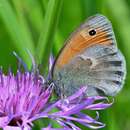Biology
(
الإنجليزية
)
المقدمة من Arkive
The small heath is quite a conspicuous butterfly despite its size. They fly only when the sun is shining and can be seen throughout the summer months. The butterfly produces two broods, a fact that explains its long flight period, from April to October if the weather allows. Its foodplants are grasses, especially the fine grasses of the Fescue and Poa genera. The eggs are laid in June and the caterpillars are a clear green in colour with a darker green stripe down the back, which helps to camouflage them from predators. The chrysalis is yellow-green and is suspended from the underside of a grass stalk or blade.
Eggs laid in June usually hatch into adults in August and provide a second population of butterflies, some of which will overwinter to breed the following spring. Some pupae, however, do not hatch until the next year.
Conservation
(
الإنجليزية
)
المقدمة من Arkive
Perhaps because the small heath is still regarded as a common UK species, few studies of its biology have been carried out. Although we have a good idea of its foodplant preferences, the full range of grasses eaten by its caterpillars is not yet known. A number of local butterfly recorders have noted a reduction in the numbers of small heaths being seen in some parts of Britain, particularly in the south of England. This may be due to loss of its preferred short grassland habitats through agricultural intensification but, as yet, this is still not fully understood.
Description
(
الإنجليزية
)
المقدمة من Arkive
The small heath is amongst the smallest of the butterflies found in the UK. It has pale orange upperwings bordered with brown and with brown veins radiating out from the point where the wing is joined to the thorax. There is also a small brown 'eye' on the top of the forewing. The underside of the wings differ in that the hindwing is largely grey with a prominent white flash across the middle. The underside of the forewing is similar to the upperside, complete with the 'eye' spot, the main difference being that the spot is fringed with yellow.
Habitat
(
الإنجليزية
)
المقدمة من Arkive
This species is essentially a grassland butterfly, but it has a preference for short grazed turf and heathland. It likes sandy or well-drained soils, but can also be seen on roadsides, parks and sometimes in gardens.
Range
(
الإنجليزية
)
المقدمة من Arkive
This butterfly has a large range and is found throughout most of the UK and Europe to latitude 69ºN. It also occurs in north Africa and eastwards to Mongolia.
Status
(
الإنجليزية
)
المقدمة من Arkive
Common. European threat status: not threatened.
Threats
(
الإنجليزية
)
المقدمة من Arkive
The main threat to this species seems to be loss of habitat. Although it is not thought to be under threat in the UK, this butterfly does appear to be declining in some parts of its British range.

